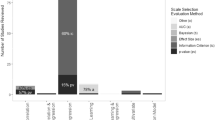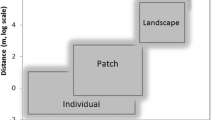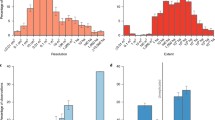Abstract
Context
Not accounting for spatial heterogeneity in ecological analyses can cause modeled relationships to vary across spatial scales, specifically different levels of spatial resolution. These varying results hinder both the utility of data collected at one spatial scale for analyses at others and the determination of underlying processes.
Objectives
To briefly review existing methods for analyzing data collected at multiple scales, highlight the effects of spatial heterogeneity on the utility of these methods, and to illustrate a practical statistical method to account for the sources of spatial heterogeneity when they are unknown.
Methods
Using simulated examples, we show how not accounting for the drivers of spatial heterogeneity in statistical models can cause contradictory findings regarding relationship direction across spatial scales. We then show how mixed effects models can remedy this multiscaling issue.
Results
Ignoring sources of spatial heterogeneity in statistical models with coarse spatial scales produced contradictory results to the true underlying relationship. Treating drivers of spatial heterogeneity as random effects in a mixed effects model, however, allowed us to uncover this true relationship.
Conclusions
Mixed effects models is advantageous as it is not always necessary to know the influential explanatory variables that cause spatial heterogeneity and no additional data are required. Furthermore, this approach is well documented, can be applied to data having various distribution types, and is easily executable using multiple statistical packages.




Similar content being viewed by others
References
Araújo MB, Rozenfeld A (2014) The geographic scaling of biotic interactions. Ecography (Cop) 37:406–415
Araújo MB, Thuiller W, Williams PH, Reginster I (2005) Downscaling European species atlas distributions to a finer resolution : implications for conservation planning. Glob Ecol Biogeogr 14:17–30
Argañaraz JP, Entraigas I (2014) Scaling functions evaluation for estimation of landscape metrics at higher resolutions. Ecol Inform 22:1–12
Azaele S, Cornell SJ, Kunin WE (2012) Downscaling species occupancy from coarse spatial scales. Ecol Appl 22:1004–1014
Bar-Massada A, Wood EM, Pidgeon AM, Radeloff VC (2012) Complex effects of scale on the relationships of landscape pattern versus avian species richness and community structure in a woodland savanna mosaic. Ecography (Cop) 35:393–411
Bates D, Maechler M, Bolker B, Walker S (2014) lme4: linear mixed-effects models using Eigen and S4
Bombi P, D’Amen M (2012) Scaling down distribution maps from atlas data: a test of different approaches with virtual species. J Biogeogr 39:640–651
Bradter U, Kunin WE, Altringham JD, Thom TJ, Benton TG (2013) Identifying appropriate spatial scales of predictors in species distribution models with the random forest algorithm. Methods Ecol Evol 4:167–174
Buckley YM, Briese DT, Rees M (2003) Demography and management of the invasive plant species Hypericum perforatum. I. Using multi-level mixed-effects models for characterizing growth, survival and fecundity in a long-term data set. J Appl Ecol 40:481–493
Cleland DT, Avers PE, McNab WH, Jensen ME, Bailey RG, King T, Russell WE (1997) National Hierarchical Framework of Ecological Units. In: Boyce M, Haney A (eds) Ecosyst manag appl sustain for wildl resour. Yale University Press, New Haven, pp 181–200
Cleland DT, Freeouf JA, Keys JE, Nowacki GJ, Carpenter CA, McNab WH (2007) Ecological subregions: sections and subsections for the conterminous United States. General Technical. Report WO-76. U.S. Department of Agriculture, Forest Service, Washington, D.C. Map, presentation scale 1:3,500,000; Albers equal area projection; colored
Cooper SD, Diehl S, Kratz K, Sarnelle O (1998) Implications of scale for patterns and processes in stream ecology. Aust J Ecol 23:27–40
Cressie NA (1993) Statistics for spatial data, revised. Wiley, New York
Dark S, Bram D (2007) The modifiable areal unit problem (MAUP) in physical geography. Prog Phys Geogr 31:471–479
Dutilleul P, Legendre P (1993) Spatial heterogeneity against heteroscedasticity: an ecological paradigm versus a statistical concept. Oikos 66:152–171
Faraway J (2006) Extending the linear model with r: generalized linear, mixed effects and nonparametric regression models. Chapman & Hall/CRC Taylor & Francis Group, Boca Raton
Fotheringham A (1989) Scale-independent spatial analysis. In: Goodchild M, Gopal S (eds) Accuracy spat databases. Taylor and Francis, London, pp 221–228
Fotheringham A, Wong D (1991) The modifiable areal unit problem in statistical analysis. Environ Plan 23:1025–1044
Frazier AE (2014) A new data aggregation technique to improve landscape metric downscaling. Landscape Ecol 29:1261–1276
Fridley JD, Stachowicz JJ, Naeem S, Sax DF, Seabloom EW, Smith MD, Stohlgren TJ, Tilman D, Von Holle B (2007) The invasion paradox: reconciling pattern and process in species invasions. Ecology 88:3–17
Gotway CA, Young LJ (2002) Combining incompatible spatial data. J Am Stat Assoc 97:632–648
Gotway CA, Young LJ (2007) A geostatistical approach to linking geographically aggregated data from different sources. J Comput Graph Stat 16:115–135
Graf RF, Bollmann K, Suter W, Bugmann H (2005) The importance of spatial scale in habitat models: Capercaillie in the Swiss Alps. Landsc Ecol 20:703–717
Greven S, Kneib T (2010) On the behaviour of marginal and conditional AIC in linear mixed models. Biometrika 97(4):773–789
Hamer KC, Hill JK (2000) Scale-dependent effects of habitat disturbance on species richness in tropical forests. Conserv Biol 14:1435–1440
Heffernan JB, Soranno PA, Angilletta MJ, Buckley LB, Gruner DS, Keitt TH, Kellner JR, Kominoski JS, Rocha AV, Xiao J, Harms TK, Goring SJ, Koenig LE, McDowell WH, Powell H, Richardson AD, Stow C, Vargas R, Weathers KC (2014) Macrosystems ecology: Understanding ecological patterns and processes at continental scales. Front Ecol Environ 12:5–14
Holland JD, Bert DG, Fahrig L (2004) Determining the spatial scale of species’ response to habitat. Bioscience 54:227–233
Iannone BI, Potter KM, Dixon Hamil K, Huang W, Zhang H, Guo Q, Oswalt CM, Woodall CW, Fei S. Understanding biotic resistance to invasions across forests of the Eastern USA. Landscape Ecol current is. (this issue)
Jackson HB, Fahrig L (2015) Are ecologists conducting research at the optimal scale? Glob Ecol Biogeogr 24:52–63
Jelinski D, Wu J (1996) The modifiable areal unit problem and implications for landscape ecology. Landscape Ecol 11:129–140
Keil P, Belmaker J, Wilson AM, Unitt P, Jetz W (2013) Downscaling of species distribution models: a hierarchical approach. Methods Ecol Evol 4:82–94
Kling A, Johnson A, O’Neill R (1991) Transmitation and functional representation of heterogeneous landscapes. Landscape Ecol 5:239–253
Laird NM, Ware JH (1982) Random-effects models for longitudinal data. Biometr Int Biometr Soc 38:963–974
Levin SA (1992) The problem of pattern and scale in ecology: the Robert H. MacArthur award lecture. Ecology 73:1943–1967
Lloyd P, Palmer AR (1998) Abiotic factors as predictors of distribution in Southern African Bulbuls. Auk 115:404–411
McGill BJ (2010) Matters of scale. Science (80-) 328:575–576
McPherson JM, Jetz W, Rogers DJ (2006) Using coarse-grained occurrence data to predict species distributions at finer spatial resolutions - possibilities and limitations. Ecol Modell 192:499–522
Müller S, Scealy JL, Welsh AH (2013) Model selection in linear mixed models. Stat Sci 28:135–167
O’Neill R, Rust B (1979) Aggregation error in ecological models. Ecol Modell 7:91–105
Openshaw S (1977) Optimal zoning systems for spatial interaction models. Environ Plan 9:169–184
Openshaw S (1983) The modifiable areal unit problem. Geo Books, Norwick, Norfolk
Peters D, Bestelmeyer B, Turner M (2007) Cross-scale interactions and changing pattern-process relationships: consequences for system dynamics. Ecosystems 10:790–796
Pettorelli N, Laurance W, O’Brien T, Wegmann M, Nagendra H, Turner W (2014) Satellite remote sensing for applied ecologists: opportunities and challenges. J Appl Ecol 51:839–848
Pinheiro J, Bates D, DebRoy S, Sarkar D, R Core Team (2013) nlme: linear and nonlinear mixed effects models, R package version 3, p 57
Powell KI, Chase JM, Knight TM (2013) Invasive plants have scale-dependent species-area relationships. Science 339(80):317–319
R Core Team (2014) R: A language and environment for statistical computing. R Foundation for Statistical Computing, Vienna
Renne IJ, Tracy BF, Rejmánek M (2003) The rich get richer: responses. Front Ecol Environ 1:122–123
Robinson WS (1950) Ecological correlations and the behavior of individuals. Am Sociol Rev 15:351–357
Saura S, Castro S (2007) Scaling functions for landscape pattern metrics derived from remotely sensed data: Are their subpixel estimates really accurate? ISPRS J Photogramm Remote Sens 62:201–216
Selvin HC (1958) Durkheim’s suicide and problems of empirical research. Am J Sociol 63:607–619
Shea K, Chesson P (2002) Community ecology theory as a framework for biological invasions. Trends Ecol Evol 17:170–176
Soranno PA, Cheruvelil KS, Bissell EG, Bremigan MT, Downing JA, Fergus CE, Filstrup CT, Henry EN, Lottig NR, Stanley EH, Stow CA, Tan P, Wagner T, Webster KE (2014) Cross-scale interactions: quantifying multi-scaled cause-effect relationships in macrosystems. Front Ecol Environ 12:65–73
Stephens S, Koons D, Rotella J, Willey D (2003) Effects of habitat fragmentation on avian nesting success: a review of the evidence at multiple spatial scales. Biol Conserv 115:101–110
Stohlgren TJ, Barnett DT, Kartesz JT (2003) The rich get richer: patterns of plant invasions in the United States. Front Ecol Environ 1:11–14
Taylor BW, Irwin RE (2004) Linking economic activities to the distribution of exotic plants. Proc Natl Acad Sci U S A 51:17725–17730
Turner MG (1989) Landscape ecology: the effect of pattern on process. Annu Rev Ecol Syst 20:171–197
Vaida F, Blanchard S (2005) Conditional Akaike information for mixed-effects models. Biometrika 92:351–370
Wakefield J, Lyons H (2010) Spatial aggregation and the ecological fallacy. In: Gelfand AE, Diggle P, Guttorp P, Fuentes M (eds) Handb spat stat. CRC Press, Stat, pp 541–558
Wheatley M, Johnson C (2009) Factors limiting our understanding of ecological scale. Ecol Complex 6:150–159
Wiens JA (1989) Spatial scaling in ecology. Funct Ecol 3:385–397
Wu J (2004) Effects of changing scale on landscape pattern analysis. Landscape Ecol 19:125–138
Wu J, Hobbs R (2002) Key issues and research priorities in landscape ecology: an idiosyncratic synthesis. Landscape Ecol 17:355–365
Wu J, Loucks O (1995) From balance of nature to hierarchical patch dynamics: a paradigm shift in ecology. Q Rev Biol 70:439–466
Wu J, Gao W, Tueller P (1997) Effects of changing spatial scale on the results of statistical analysis with landscape data: a case study. Geogr Inf Sci 3:30–41
Zhang H, El-Shaarawi A (2010) On spatial skew-Gaussian processes and applications. Environmetrics 21:33–47
Zuur AF, Ieno EN, Walker NJ, Savekiev AA, Smith GM (2009) Mixed Effects Models and Extensions in Ecology with R. Springer Science and Business Media, New York
Acknowledgments
Funding was provided by a NSF Macrosystem Biology Grant # 1241932. We would like to thank Dr. Jianguo Wu for comments that greatly improved the overall quality of this paper.
Author information
Authors and Affiliations
Corresponding author
Additional information
Special issue: Macrosystems ecology: Novel methods and new understanding of multi-scale patterns and processes.
Guest Editors: S. Fei, Q. Guo, and K. Potter.
Rights and permissions
About this article
Cite this article
Dixon Hamil, KA., Iannone III, B.V., Huang, W.K. et al. Cross-scale contradictions in ecological relationships. Landscape Ecol 31, 7–18 (2016). https://doi.org/10.1007/s10980-015-0288-z
Received:
Accepted:
Published:
Issue Date:
DOI: https://doi.org/10.1007/s10980-015-0288-z




